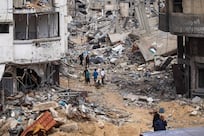Five years ago off the west coast of Sumatra, Indonesia, a 9.1 magnitude earthquake - the second strongest earthquake ever recorded - produced a 30m high tsunami that brought devastation to much of south east and south Asia. Resulting in a death toll of around 230,000 people, the Indian Ocean Tsunami was the largest in that region for over 700 years. While Indonesia, Sri Lanka, India, and Thailand were hardest hit, the north Indonesian province of Aceh bore the brunt of the catastrophe, The New York Times said. "The provincial capital, Banda Aceh, was devastated. An estimated 170,000 people here were killed, including 35,000 whose bodies were never found. "In the five years since, more than 800 nongovernmental organisations, multilateral agencies and donor countries have combined to spend $6.7 billion, nearly all the amount pledged from around the world to rebuild Aceh. Although by most accounts it has been a success, the process, still incomplete, has not been without challenges. "No functioning government existed here in the early days to coordinate the arriving international aid agencies. While Indonesia's central government mobilised during the emergency phase, it would be four months before it set up an agency to manage the reconstruction. "Questions of land ownership, obscured by the destruction of property and records, also delayed rebuilding. Perhaps the greatest complication was the three-decade-old separatist conflict in Aceh, which ended in a peace deal between the rebels and the government six months after the tsunami. "It was in this climate that the United States won the right to build its signature project - a $250 million highway running 150 kilometers down Aceh's western coast, from Banda Aceh to Calang, to reconnect displaced communities to the outside world. "Managed by the US Agency for International Development, the project was seen by Jakarta and Washington as vital both to immediate reconstruction and to Aceh's economic development for decades to come." Akash Kapur described how he initially viewed with cynicism the arrival of aid workers in the south east Indian state of Tamil Nadu, yet five years later said that aid money had transformed the region. In Thantirayankuppam, a fishing hamlet of around 430 people, a woman named J Sasikala told him about losing all her possessions in the tsunami. For months, her family was homeless and depended on strangers for food. Five years on, Ms Sasikala and a friend, a woman named K Laxmi, talked about all the ways their lives had changed since the tsunami. "They talked about their new houses, their electricity and gas connections, and about the handicrafts training they had received from a nongovernmental organisation. "They also talked about the fact that their homes were legally in their names. Not too long after the tsunami, government officials came through the village and announced that all new homes would be titled in the name of women (some were jointly titled to men and women). The men grumbled, but the officials told them they had no choice. Men drank and gambled, they said; women were more reliable. "Almost 50,000 houses have been built along the coast of Tamil Nadu. The result of titling these homes to women has transcended the economic gains of home ownership. It has changed the very social fabric of the coast. "In village after village, I heard stories of women whose status at home and in society had been utterly transformed. Wives spoke of a new self-confidence and about greater control over household finances. Mothers talked about insisting that their daughters went to school. "Men also talked about their wives' new assertiveness. They joked - with an anxious edge - that they had learned to behave, for fear that they might get thrown out of their homes." In The National, Larry Jagan noted: "Since the tsunami, many countries in Asia have been galvanised into action. There has been increased investment in tsunami warning systems, and simulation exercises conducted throughout the region in the past few years. The Association of South-East Asian Nations has also adopted a regional approach to natural disasters - setting up a department to deal with them. "But fears remain that Asia will be just as vulnerable as ever to massive damage and loss of lives if another major tsunami were to hit the region. In September, the Jakarta Earthquake and Tsunami Center failed to issue a tsunami warning after a powerful earthquake struck the large Indonesian island of Sumatra, according to Danny Hilman Natawidjaja, a senior geological researcher at the Indonesian Institute of Sciences. "More than 1,000 people died in the quake - mostly trapped in collapsed buildings and landslides. But it also triggered a small tsunami, according to the tide gauges off Sumatra. " 'Fortunately there was no big tsunami. If there had been a tsunami, I can't imagine how many people would have died,' Mr Natawidjaja said." Feizal Samanth wrote: "Five years after the tsunami swept over the shores of Sri Lanka destroying everything in its path, victims are continuing to rebuild their lives. But their efforts have been plagued by nagging questions over widespread corruption in programmes expected to provide thousands of houses worth billions of rupees. "More than 35,000 people in Sri Lanka were killed and more than a half million displaced when an earthquake off the Indonesian coast on December 26, 2004 triggered a series of tsunamis along coastlines in the Indian Ocean. Nearly 100,000 houses in Sri Lanka were destroyed by the deadly waves." An editorial in The Australian said: "Transparency International claims that almost $537 million in tsunami aid remains unaccounted for in Sri Lanka and that more than $686m was spent on projects unrelated to the disaster. "The Sri Lankan government has rejected such accusations in the past, but its own audit in 2005 found that less than 13 per cent of the aid had been spent. The most recent census, in 2007, showed almost 9,000 people still in temporary shelters. Rebuilding had been slowed by the long-running civil war between the government and Tamil Tigers, which ended in May. "It would be a tragedy if the whiff of corruption deterred individuals, organisations and governments from responding generously to natural disasters in the future. "For this reason, the concerns raised by Transparency International must be investigated thoroughly and the outcomes reported."
pwoodward@thenational.ae





